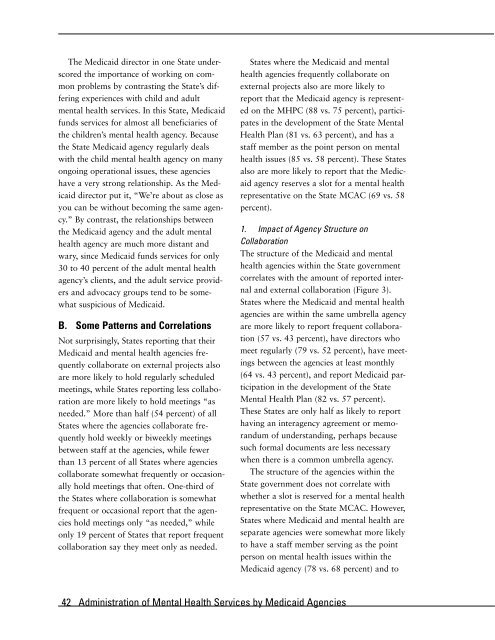Administration of Mental Health Services by Medicaid Agencies
Administration of Mental Health Services by Medicaid Agencies
Administration of Mental Health Services by Medicaid Agencies
Create successful ePaper yourself
Turn your PDF publications into a flip-book with our unique Google optimized e-Paper software.
The <strong>Medicaid</strong> director in one State underscoredthe importance <strong>of</strong> working on commonproblems <strong>by</strong> contrasting the State’s differingexperiences with child and adultmental health services. In this State, <strong>Medicaid</strong>funds services for almost all beneficiaries <strong>of</strong>the children’s mental health agency. Becausethe State <strong>Medicaid</strong> agency regularly dealswith the child mental health agency on manyongoing operational issues, these agencieshave a very strong relationship. As the <strong>Medicaid</strong>director put it, “We’re about as close asyou can be without becoming the same agency.”By contrast, the relationships betweenthe <strong>Medicaid</strong> agency and the adult mentalhealth agency are much more distant andwary, since <strong>Medicaid</strong> funds services for only30 to 40 percent <strong>of</strong> the adult mental healthagency’s clients, and the adult service providersand advocacy groups tend to be somewhatsuspicious <strong>of</strong> <strong>Medicaid</strong>.B. Some Patterns and CorrelationsNot surprisingly, States reporting that their<strong>Medicaid</strong> and mental health agencies frequentlycollaborate on external projects alsoare more likely to hold regularly scheduledmeetings, while States reporting less collaborationare more likely to hold meetings “asneeded.” More than half (54 percent) <strong>of</strong> allStates where the agencies collaborate frequentlyhold weekly or biweekly meetingsbetween staff at the agencies, while fewerthan 13 percent <strong>of</strong> all States where agenciescollaborate somewhat frequently or occasionallyhold meetings that <strong>of</strong>ten. One-third <strong>of</strong>the States where collaboration is somewhatfrequent or occasional report that the agencieshold meetings only “as needed,” whileonly 19 percent <strong>of</strong> States that report frequentcollaboration say they meet only as needed.States where the <strong>Medicaid</strong> and mentalhealth agencies frequently collaborate onexternal projects also are more likely toreport that the <strong>Medicaid</strong> agency is representedon the MHPC (88 vs. 75 percent), participatesin the development <strong>of</strong> the State <strong>Mental</strong><strong>Health</strong> Plan (81 vs. 63 percent), and has astaff member as the point person on mentalhealth issues (85 vs. 58 percent). These Statesalso are more likely to report that the <strong>Medicaid</strong>agency reserves a slot for a mental healthrepresentative on the State MCAC (69 vs. 58percent).1. Impact <strong>of</strong> Agency Structure onCollaborationThe structure <strong>of</strong> the <strong>Medicaid</strong> and mentalhealth agencies within the State governmentcorrelates with the amount <strong>of</strong> reported internaland external collaboration (Figure 3).States where the <strong>Medicaid</strong> and mental healthagencies are within the same umbrella agencyare more likely to report frequent collaboration(57 vs. 43 percent), have directors whomeet regularly (79 vs. 52 percent), have meetingsbetween the agencies at least monthly(64 vs. 43 percent), and report <strong>Medicaid</strong> participationin the development <strong>of</strong> the State<strong>Mental</strong> <strong>Health</strong> Plan (82 vs. 57 percent).These States are only half as likely to reporthaving an interagency agreement or memorandum<strong>of</strong> understanding, perhaps becausesuch formal documents are less necessarywhen there is a common umbrella agency.The structure <strong>of</strong> the agencies within theState government does not correlate withwhether a slot is reserved for a mental healthrepresentative on the State MCAC. However,States where <strong>Medicaid</strong> and mental health areseparate agencies were somewhat more likelyto have a staff member serving as the pointperson on mental health issues within the<strong>Medicaid</strong> agency (78 vs. 68 percent) and to42 <strong>Administration</strong> <strong>of</strong> <strong>Mental</strong> <strong>Health</strong> <strong>Services</strong> <strong>by</strong> <strong>Medicaid</strong> <strong>Agencies</strong>
















